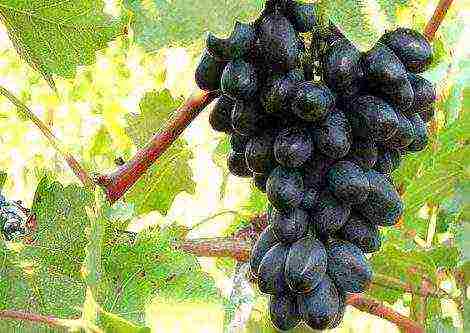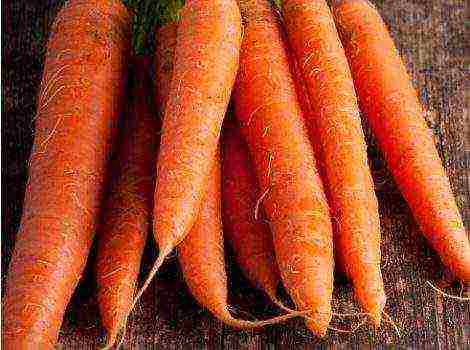Content
- 0.1 Ground cover rose of the ‘Akhtiar’ variety
- 0.2 'Ballerina' ground cover rose
- 0.3 'Bonica' ground cover rose
- 0.4 ‘Concerto’ ground cover rose
- 0.5 'Fair Play' groundcover rose
- 0.6 'Ferdy' groundcover rose
- 0.7 Groundcover 'Fiona' rose
- 0.8 'Fleurette' ground cover rose
- 0.9 'Immensee' ground cover rose
- 0.10 'Kent' ground cover rose
- 0.11 ‘Nozomi’ ground cover rose
- 1 'Patte de Velours' ground cover rose
- 2 'Snow Ballet' groundcover rose
- 3 Most popular varieties
- 4 Features of growing ground cover roses
- 5 Planting and leaving
- 6 Reproduction of roses
- 7 Preparing for winter
- 8 Ocean of different roses
- 9 Features of growing ground cover roses
- 10 Landscaping techniques
- 11 Popular varieties for Russia, Belarus and Ukraine
- 12 Planting ground cover roses
- 13 Caring for ground cover roses
- 14 Reproduction
- 15 Groundcover roses in garden design
- 16 The best varieties of ground cover roses
IN
previous article
we learned about ground cover roses, their use and placement in the country, and now I will tell you about their best varieties.
Ground cover rose of the ‘Akhtiar’ variety

An exquisite snow-white variety created by Zinaida Konstantinovna Klimenko in the Nikitsky Botanical Garden (Yalta, Crimea) in 2003. The bush is powerful, from 70 cm to 1.2 m high, with arched shoots. The leaves are dark green, shiny. The flowers are white, cupped, large, more than 10 cm in diameter, double, collected in inflorescences, 5-6 cm long, with a strong aroma. Flowering once, very abundant. Suitable for solitary (single) and group plantings, borders, live flowering hedges and boles.
'Ballerina' ground cover rose
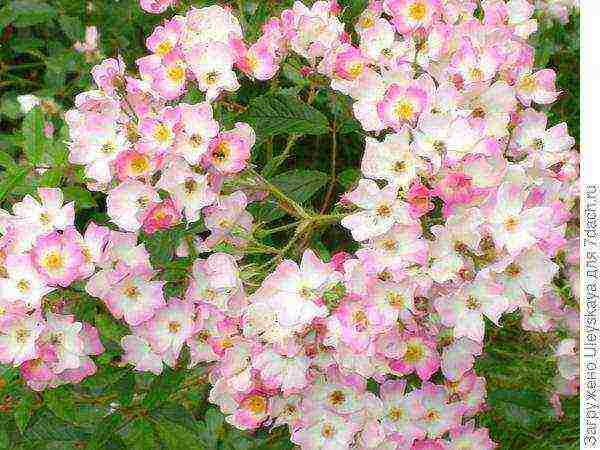
An unusually beautiful variety, deservedly awarded the title of "Best Classic Scrub" of the AARS Rose Competition in the USA in 1998-2001. The bush is 70-90 cm high and up to 1.2 m wide. The leaves are dark green, small. The flowers are pink with a white center, non-double (5-8 petals), 4-5 cm in diameter, with a slight aroma and hints of musk; collected in large inflorescences, bearing up to 40-50 flowers; bloom from June to November. Advantages of the variety: frost-resistant, shade-tolerant, tolerates hot summers well, moderately resistant to diseases. Planting density: 3 pcs. for 1 sq. m.
'Bonica' ground cover rose
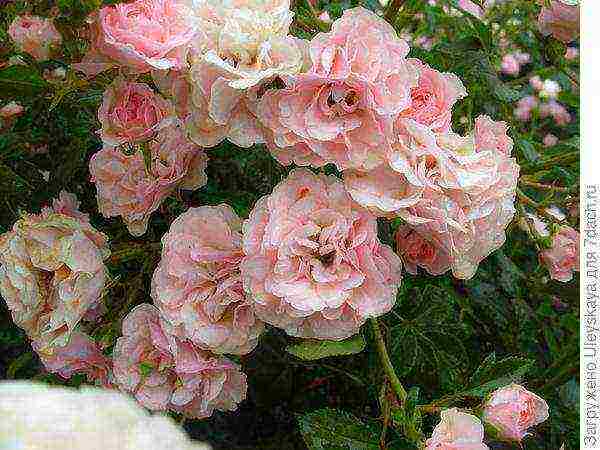
A fine, delicate variety that can be found on the market under the names Rosa ‘Bonica 82’, Rosa ‘Meidonomac’. The bush is sprawling, powerful, 85 cm high and up to 1.1 m wide. The leaves are dark green, small. The flowers are pink, double, medium, up to 7 cm in diameter, without aroma, collected in small inflorescences. Flowering is abundant, long-lasting, the first wave is the strongest, again - weaker, in early autumn a burst of flowering is possible. Suitable for groups, wide flower borders, decorating a bed, containers, good for cutting for low vases. Cons of the variety: pink flowers quickly fade in the sun to white. In humid climates and in autumn, it is affected by black spot. Planting density: 5-6 pcs. for 1 sq. m.
‘Concerto’ ground cover rose

An amazingly beautiful variety with flowers of a rare light apricot color, created by the French company Meilland in 1995. Bush up to 1 m high, densely leafy. The leaves are green, disease resistant. Terry flowers, collected in inflorescences up to 15 flowers. The flowering is very abundant.
'Fair Play' groundcover rose

A luxurious variety created by Interplant in 1977. Spreading bush, up to 1 m high, up to 2 m wide. Leaves are dark green, large, shiny. The flowers are pink, semi-double, consisting of 15-18 petals, up to 5 cm in diameter; collected in large inflorescences, consisting of a large number of flowers (up to 50), fragrant.Abundant flowering, can be repeated until frost. Suitable for terraced slopes, flowering borders, for planting in mixborders, boles. Advantages of the variety: winter-hardy, disease-resistant. Planting density: 3 pcs. for 1 sq. m.
'Ferdy' groundcover rose
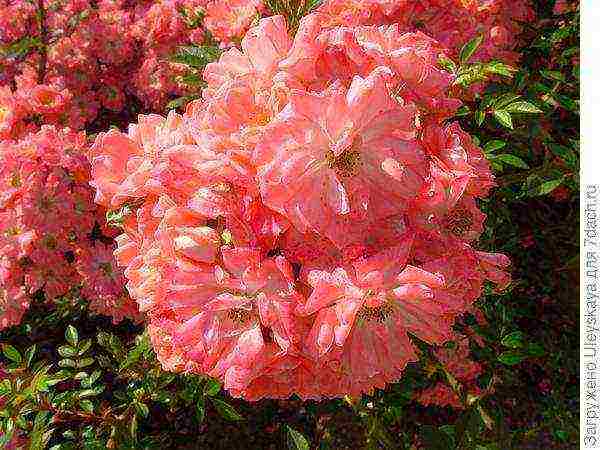
An excellent Japanese variety that has several names. In addition to the first - priority, it can be found on sale as Rosa ‘Ferdi’, Rosa ’Keitoly’. The variety was created in 1984. The bush is 80 cm high and 1.2 m wide. The leaves are green, not shiny, very small. The flowers are bright pink, semi-double, 2.5-4 cm in diameter, without aroma, collected in inflorescences. The first bloom is very abundant, blooming from summer to autumn. Used for tapeworms, in groups, on boles, in high curbs. Despite the fact that in the English reference literature regarding this variety, a winter minimum of 15 ° C is given, summer residents note that it winters well in the conditions of the Moscow region with light shelter.
Groundcover 'Fiona' rose
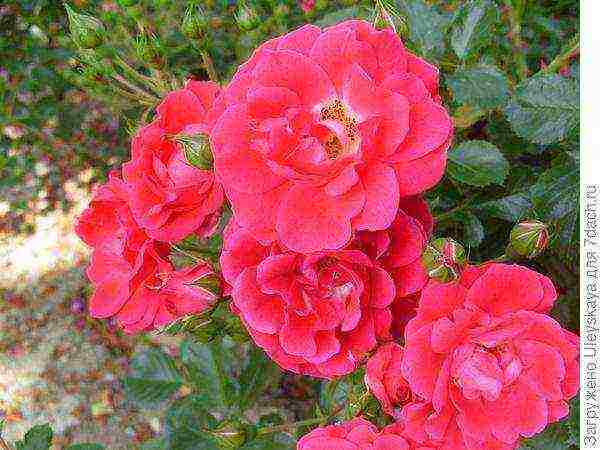
The personal rose variety bearing the female name is Fiona ("contemplating on God"), created in Germany by Kordes in 1976, so it can be found on sale under the name Rosa ‘Meibeluxen’. The bush is powerful, 80 cm high and 1.2 m wide, with arched shoots. The leaves are dark green, shiny. The flowers are bright pink, 6 cm in diameter, double, slightly fragrant, collected in large inflorescences. Flowering is abundant and prolonged from June to November (southern coast of Crimea). The variety is winter-hardy, very disease-resistant.
'Fleurette' groundcover rose
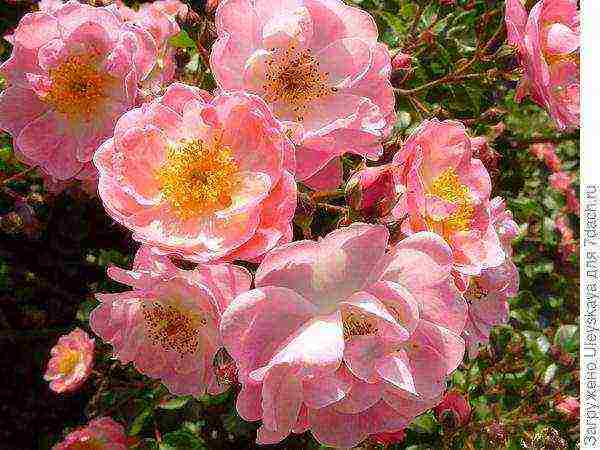
A personal variety, the name of which in translation from French means "flower". Created by Interplant in 1977. Shrub up to 90-100 cm high. Leaves are dark green, shiny. The flowers are pink, with a white center, open, semi-double, with a weak aroma. Flowering is very abundant and long-lasting, on the southern coast of Crimea from June to January.
'Immensee' groundcover rose
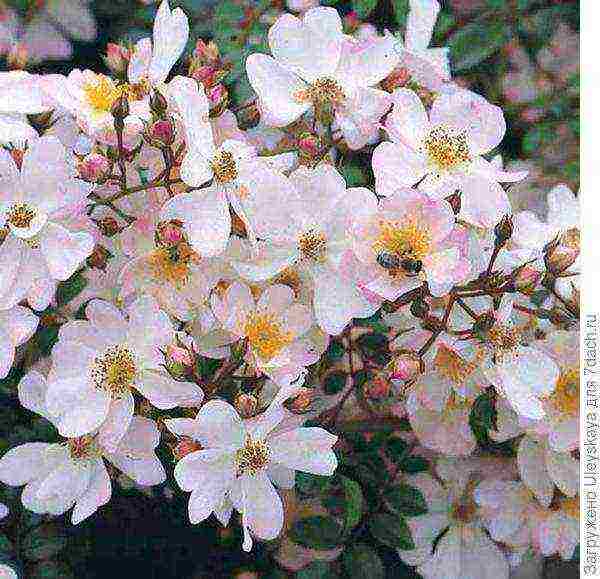
An excellent variety, created in Germany by Kordes in 1982. On sale it can be found under the following names: Rosa 'Grouse', Rosa 'Korimro', Rosa 'Lac Rose'. The bush is 60 cm high and up to 3 m wide. The leaves are dark green, shiny. The flowers are light pink, 4 cm in diameter, simple, collected in inflorescences, fragrant. Blooms until autumn frosts. Resistant to disease. Good on boles, suitable for decorating slopes, creating borders.
'Kent' ground cover rose
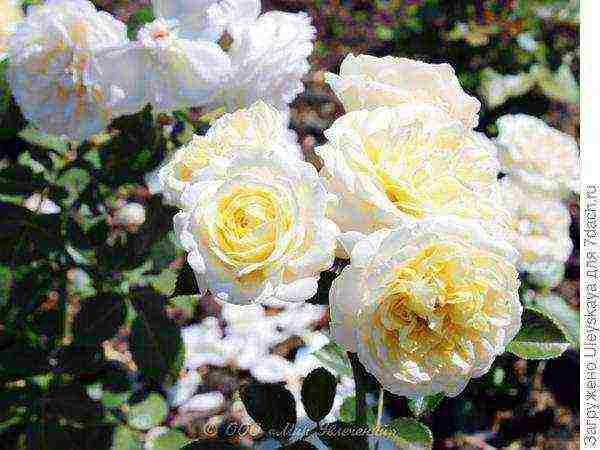
An aristocratic white variety, created in 1988. On the market it can be found under the names Rose ‘Poulcov’, Rosa ‘Pyrenees’, Rosa ‘White Cover’. The bush is 45 cm high and up to 1 m wide. The leaves are dark green, leathery, shiny. The flowers are white, semi-double, large, 4.5 cm in diameter, very fragrant, single or in inflorescences. Abundant flowering, sometimes ending only in autumn. Interesting in group plantings, mixborders.
'Nozomi' groundcover rose

A very spectacular rose, created back in 1968, but the interest in it is enormous, since in terms of the power of flowering, the number of flowers, it has no equal. On sale, it may show up under the name Rosa ‘Heideroslein’. The bush is 45-60 cm high and up to 1.2 m wide. The leaves are small, leathery, shiny. The flowers are white, small, 2.5 cm in diameter, simple with 5 petals, with a light aroma, collected in inflorescences of 3-8 flowers, but there are so many of them that you cannot see the leaves. Suitable for decorating slopes, rocky gardens, boles. Advantages of the variety: highly resistant to diseases, winter-hardy. Planting density: 3-4 pcs. for 1 sq. m.
'Patte de Velours' ground cover rose
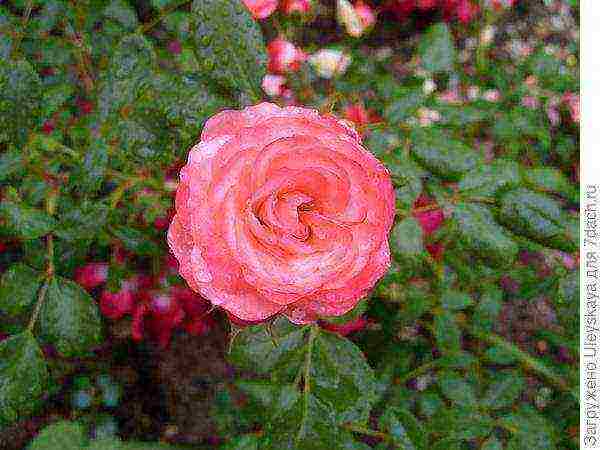
An exquisite variety created by the French company Meilland in 2000. Bush up to 1.2 m high. Pink flowers, changing color, double, up to 40-50 petals, 5-6 cm in diameter, single or collected in inflorescences. Suitable for curbs and hedges. Timely removal of faded flowers prolongs the decorative effect of the rose.
'Rouge Meillandecor' ground cover rose
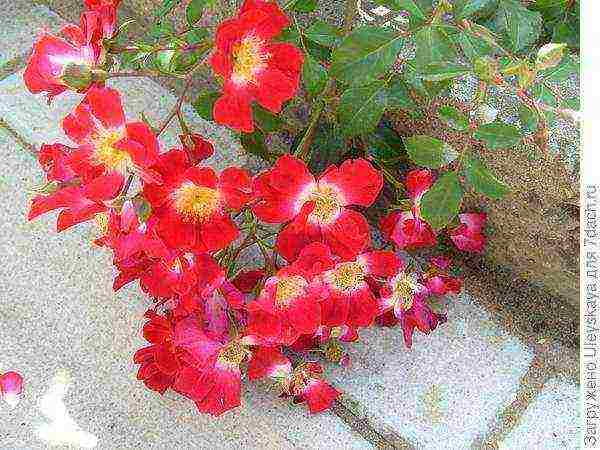
A very effective variety, created by Meilland in 1989. The bush is 60-80 cm high. The leaves are green, leathery, shiny. The flowers are red, with a white eye and yellow stamens, simple, up to 7 cm in diameter, collected in inflorescences bearing up to 10-15 flowers. Abundant flowering, long lasting. A frost-resistant variety, resistant to diseases, tolerates partial shade, grows in the 2nd year after planting. Planting density: 5 pcs. for 1 sq. m. Interesting in standard form.
'Snow Ballet' groundcover rose

An excellent variety, the name of which translates as "snow ballet", was created by Clayworth in 1978. The bush is 70 cm high, the shoots are strong, up to 4 m long. The leaves are dark green, leathery, shiny. The flowers are white, with a subtle pink tint, up to 7 cm in diameter, densely double, very fragrant, collected in large inflorescences. Blooms from June to December (on the South Coast). Effective on boles.
'Swany' groundcover rose

Another snow-white beauty. The variety was created in 1977. It can be found on the market under the name Rosa 'Meiburenac'. The bush is powerful, up to 75 cm high and up to 1.7 m wide, continuously forming new shoots and flowers. The leaves are green, shiny. The flowers are pure white, double, 5 cm in diameter, fragrant, single or collected in inflorescences. Abundant flowering, long lasting, throughout the summer. Suitable for landscaping slopes, a rabatok, for boles.
'Weisse Immensee' ground cover rose
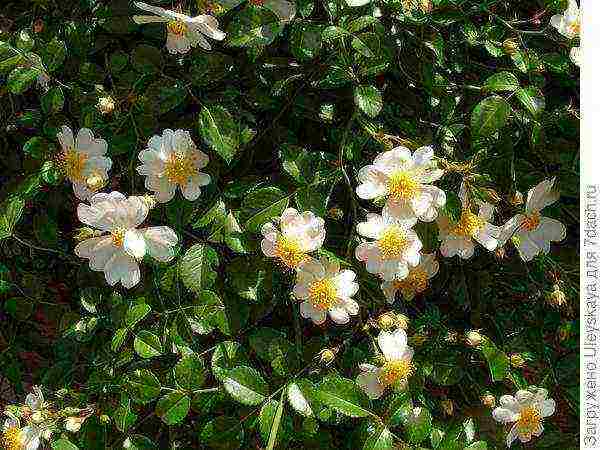
A very interesting variety, created in Germany in 1982. The bush is 0.5 m high with shoots up to 2-4 m long. The leaves are bright green, shiny. The flowers are pure white with golden stamens, up to 6 cm in diameter, non-double, collected in inflorescences, very fragrant. Flowering is abundant and long: until December on the South Coast. Suitable for boles, landscaping slopes, creating flowering hedges.
And what kind of ground cover roses are weaving carpets in your country house?
Gardeners have been growing small, branchy varieties of roses as early as the 19th century. But only at the end of the 20th century unpretentious, frost-resistant, long-blooming and very decorative ground cover roses have taken their rightful place in the arsenal of landscape designers and amateur gardeners.
Most popular varieties
Halloween (Hello)
Halloween (Hello)
Low (about 50 cm), spreading bush. They are distinguished by large, densely double flowers, which during flowering change color from dark red to rich cherry... Flowers are odorless, but with the richest doubleness among ground cover roses. The variety is frost-resistant, immune, blooming profusely.
Swany
Swany
The bushes are high, 75-80 cm.The crown is spreading, up to 2 m in diameter. The Swanee rose stands out for its evergreen small shiny foliage and large umbrella inflorescences... Each contains up to 20 double, white with a pink center, fragrant flowers. Winter-hardy and very ornamental shrub.
Ahtiar
Standard rose Ahtiar (Ahtiar)
A tall shrub with long (1.2-1.5 m) falling arched shoots. Large double flowers are collected in inflorescences. This landscape rose is used to create curbs and green hedges., grown in standard culture.
Ballerina
Ballerina
Tall, up to 2 m, bush with a rounded dense crown. Winter hardy, drought and disease resistant. Blooms for a long time, continuously, until the onset of frost... Simple flowers are collected in clusters. The petals are white in the center, turning pink towards the edges. During flowering, the flowers increase in size, brighten somewhat. They have a delicate musky aroma.
Scarlet
Scarlet
One of the most hardy and adaptive varieties... Bushes are low, up to half a meter. The foliage is dark, glossy. The flowers are double, deep red. Blooms profusely, all summer and autumn
Fairy
Fairy
Saplings take root quickly, shoots grow actively and in a short time form dense thickets up to 60 cm high. White, sometimes with a pink tint, double flowers are collected in a brush of 30-40 pieces... Bloom from July to frost.
Amber Sun
Amber Sun
Sprawling branchy bushes, 50-60 cm in height and in width. Drooping branches. Small semi-double fragrant flowers of all shades of yellow - from copper at the beginning of flowering to cream at the end. Prized for long flowering, cheerful decorativeness, resistance to frost and diseases of roses.
Matador
Matador
Low (up to half a meter) compact bushes. Scarlet semi-double flowers are grouped in brushes. One of the earliest flowering varieties, extremely disease resistant, hardy to environmental conditions... Often planted in hanging pots and containers.
Fiona
Fiona
Strong bush up to 85 cm, with long arched branches. Fragrant flowers are double, bright pink, medium-sized, collected in inflorescences... Blooms profusely from early June until frost.Winter hardy immune variety.
Features of growing ground cover roses
These plants were singled out into a separate group about 50 years ago. It combines profusely flowering shrubs with wide creeping or slightly drooping arched shoots. Height from 40 cm to 2 m, crown width from 50 cm to 3 m.
Ground cover roses
Plants are well leafy, the leaves are medium-sized, shiny, form a dense green crown. Small flowers are double, semi-double or simple, collected in inflorescences, graceful and elegant.
For the ability to form dense flowering coatings, they are called carpet roses. They are used to create elements of landscape design and garden decor, therefore they are also called landscape ones.
Advantages common to ground cover roses:
- unpretentiousness, ease of care;
- frost resistance;
- immunity to diseases and pests;
- abundant long flowering;
- easy reproduction by layering;
- rapid growth and acquisition of a decorative appearance;
- from 2 years old they suppress weeds.
They are planted along the paths, in the lower tier of flower beds, in rabat beds. With their help, they create color accents on lawns, enliven gentle slopes, decorate retaining walls and terraces.... Compact varieties look great in planters and wicker baskets.
Planting and leaving
Landing dates and site selection
Carpet roses are planted in spring or early fall, long before the onset of frost. In the regions of the middle lane and to the north, spring plantings are preferred.to give the plants time to take root and grow stronger.
The soil is chosen fertile, loamy, loose, well-moistened and drained.
Roses do not tolerate stagnant moisture in the soil and high-standing groundwater. A good solution is placement on raised beds or gentle slopes.
Provide good lighting for the rose garden... At the same time, light partial shade in the sultry afternoon hours will not hurt.
Good placement for roses - on the western or southeastern steep slopes.
How to plant
The variety is selected taking into account its "adult" size, planned use, placement on the site.
 Spring is the most favorable time of the year for planting
Spring is the most favorable time of the year for planting
For a pink flower bed, dig the entire planting area into 2 bayonets of a shovel in depth.
Before planting, you need to carefully select from the soil plant residues, weeds and their rhizomes. Subsequently, it is difficult to remove weeds from under the thorny bushes.
Pits are prepared 50 cm in diameter and to a depth of 60-70 cm on average, but 10-20 cm longer than the length of the roots of the seedling. To plant a curb or hedge, dig a trench... The bottom is loosened by 25-35 cm.
Shoots are shortened, leaving 2-4 buds on each. Dry and damaged roots are cut off. The seedling is placed in a hole, covered with soil. Every layer of earth is watered.
From above, the soil is compacted and again watered abundantly.
Care
Young bushes are watered 2 times a week, adults - 1 time in 7-10 days. Overfilling and overdrying are undesirable.
They are fed three times a season:
- after the appearance of leaves;
- after the first wave of flowering and removal of old inflorescences;
- early autumn.
The first two times they apply complex mineral fertilizers, the third - only phosphorus and potash fertilizers.
 In spring, old unopened leaves are removed on rose bushes and sanitary pruning is carried out
In spring, old unopened leaves are removed on rose bushes and sanitary pruning is carried out
Cut off shoots in early spring:
- dried up;
- frozen;
- broken;
- sick.
Young plantings are mulched with bark, shavings, leaf compost or cover the soil with a black film. These measures will prevent the development of weeds.
Adult landscape roses cover the soil surface tightly and oppress weeds.
Reproduction of roses
Groundcover roses are easily propagated by layering.
In the spring, one or more long shoots are chosen. Dig into a deep groove (10cm deep) in one or more places so that there are 1-2 buds at the bottom for the formation of roots, and 1-2 buds on top, from which shoots are formed. Fasten with hooks or wooden pins, watered.
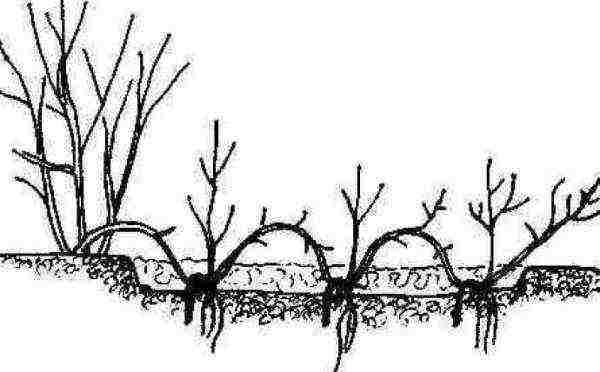 Breeding scheme for ground cover roses by layering
Breeding scheme for ground cover roses by layering
The soil is kept moist until autumn. For the winter, the shoots are covered with spruce branches... In the spring, cuttings are separated from the mother plant and transplanted to the desired location.
Preparing for winter
For better preparation for winter and ripening of shoots in the fall, watering and feeding of roses is stopped.
Ground cover plants are considered winter-hardy and do not need shelter..
In the domestic climate, this is true only for the southern regions and areas with mild snowy winters. It is advisable to protect the bushes with spruce branches or lukrasil, creating an additional air cushion.
Ground cover roses are unpretentious in care and cultivation, novice gardeners can cope with it... They respond to care and attention with abundant flowering and delight with a riot of colors, grace, spectacular decorativeness.
 Ground cover roses refer to the broadest and ever-increasing range of low-growing shrub roses, from dwarf, branchy, upright bushes to forms that creep along the ground. Particularly popular are the "widespread" varieties, which, despite being bushy, can be grown in pots, vases and hanging baskets.
Ground cover roses refer to the broadest and ever-increasing range of low-growing shrub roses, from dwarf, branchy, upright bushes to forms that creep along the ground. Particularly popular are the "widespread" varieties, which, despite being bushy, can be grown in pots, vases and hanging baskets.
Ocean of different roses
A huge number of numerous and varied varieties of ground cover roses are characterized by long and abundant flowering periodas well as increased resistance to disease. Among this variety, you can choose types for the following design techniques:
- classic decorative landscaping of small surfaces and mounds;
- constructions of colorful borders and hedges;
- decoration with color spots of mixed perennial flower beds;
- decorating gazebos, terraces, patios, balconies and other architectural forms.
Not yet approved, but already proposed by German breeders, the official international classification of ground cover roses. The term "ground cover" is proposed to be replaced by "low-growing shrub" and introduce the next gradation, which is based on differences in the height of the bush and the type of growth of its shoots:
-
 Bushes with long creeping shoots.
Bushes with long creeping shoots. - Roses with arched flowing stems.
- Broadly branching creeping bushes.
- Low, upright shrubs with a wide scattering halo.
- Small, compact shrubs with short creeping shoots.
Proven German scenery
Amber sun (Amber Sun, 2005). A versatile, wide-branched shrub with cascading shoots, for mixed flower beds, borders, tall street vases and hanging baskets. It is appreciated for its unusual color: young flowers and buds are copper-yellow, and closer to wilting, they brighten to a creamy yellow color.
Eskimo (Eskimo, 2006). Ideal for green and white hedges - it grows more in height (up to 0.8 m) than in width. Easy to care for - the flowers are self-cleaning, and the branches do not need pruning. White simple flowers are collected in clusters of 8 pieces.
Stadt rom (Stadt Rohm, 2007). Winner of numerous awards at international exhibitions. The undersized half-meter bushes are covered with a huge number of brushes with simple, pink flowers of a pastel-salmon shade that do not fade even in strong sun.
Candia Meidiland (Candia. Meidiland, 2007) The cultivar fell in love with its special three-color color of non-double flowers. The underside of the petals is white, the petals on top are bright red, scarlet, and the middle is painted yellow and covered with a large number of "curly" stamens.
Larissa (Larissa, 2008). A bush with arched falling branches up to 1 m long and a huge number of traditional pink double flowers, self-cleaning and collected in a brush.
Lavender Meidiland (Lavender Maidiland, 2008). The variety is intended for cultivation in flowerpots and tubs. Simple flowers of pink color with lavender tint are collected in small clusters. It is especially attractive for its color fastness and subtle, unusual odor and aroma.
Jazz (Jazz, 2008). An upright, spreading, self-cleaning bush grows up to a maximum of 70 cm.The variety is liked for its unusual multi-colored color of flowers - each flower has its own shade - peach, yellow, copper, orange, golden. Bush
Pretty star (Preti Star, 2008) Another upright bush (0.8 m), continuous flowering with exotic medium-sized flowers. The acid-lemon yellow color looks great against the background of small, dark green, almost black foliage.
Solera (Solero, 2009) German breakthrough breeding for breeding rose bushes with special protective properties against diseases. Widely growing shrub, with branches up to 0.7 m long. Cup-shaped double single flowers are painted in bright yellow lemon shades.
 Lipstick (Lipstick, 2011). The variety perfectly resists all diseases affecting foliage. The color of semi-double flowers is unusual: the lower part is painted white, and the upper part is an intense violet-carmine color with a pink tint. The bush is spreading, with an arcuate drop of meter-long branches. The aroma is rose hips, with a thin trail of tea rose aftertaste.
Lipstick (Lipstick, 2011). The variety perfectly resists all diseases affecting foliage. The color of semi-double flowers is unusual: the lower part is painted white, and the upper part is an intense violet-carmine color with a pink tint. The bush is spreading, with an arcuate drop of meter-long branches. The aroma is rose hips, with a thin trail of tea rose aftertaste.
Residenz (Residentz, 2012). A unique rose that perfectly resists all types of diseases and easily tolerates drought or heavy rains. It is also valued for its extended flowering period and decorative effect of flowers - the petals of semi-double racepal inflorescences are painted in an intense carmine color, with a contrasting light pink center.
Matador (Matador, 2012). Disease-resistant selection of self-cleaning compact (0.5 m) bushes of scarlet semi-double carpal roses. It is appreciated for its unusually early flowering.
Fashionable imitation of the legendary "Englishwomen"
One of the most famous breeders of ground cover roses is the Englishman David Austin. Its collection is so wide that it demanded to introduce subgroups for the name catalog of hybrids: 1) old, 2) musky, 3) white rose selection, 4) Leander.
Of course, his work has found a lot of fans and imitators in many countries around the world. Today, the following replicas of his famous hybrids are recognized as ground cover queens among flower queens. Here are their names.
Appleblossom Flower Carpet... Pale pink German mutation of the original English crimson original Flower Carpet. The bushes are distinguished by their special winter hardiness and increased resistance to various diseases.
Generosa... A popular imitation hybrid from the French nursery Guillot. This version is characterized by a very intense, delicious aroma, increased vitality and minimal maintenance.
Knock out... A hybrid from the USA, which is rightfully considered a triumph of modern breeding - it is so unpretentious that it will grow on any soils and areas, regardless of lighting, and in terms of winter hardiness and disease resistance, it has no equal.
World celebrities
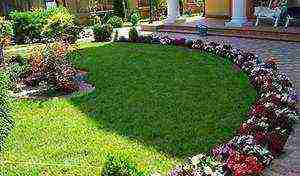 Scabrosa... A hybrid of rose and rugosa by maestro Robert Holmes. Purple flowers are non-double, slightly wrinkled, up to 9 cm in size. An extremely unpretentious and viable shrub (up to 1 m) that does not require maintenance. It blooms several times during the season. The resulting fruits are extremely decorative, do not require removal - they resemble medium-sized tomatoes. Cut flowers do not last long. Unlike fruits, which will be a great decoration for dried flowers.
Scabrosa... A hybrid of rose and rugosa by maestro Robert Holmes. Purple flowers are non-double, slightly wrinkled, up to 9 cm in size. An extremely unpretentious and viable shrub (up to 1 m) that does not require maintenance. It blooms several times during the season. The resulting fruits are extremely decorative, do not require removal - they resemble medium-sized tomatoes. Cut flowers do not last long. Unlike fruits, which will be a great decoration for dried flowers.
Rosa Schoener’s nutkana... The original flower shape (up to 9 cm) from the American George Schenser. Rose petals and fluffy yellow center are located on stems (1.5 m) without thorns. Numerous petals will open until a kind of dense disc forms. When pruned correctly, ball-shaped bushes look great next to plants whose foliage will be intensely colored in the fall. Withstands frosts down to -20 ° C.
Sophy's Rose... English selection, 1997. Delightful round compact bushes of scarlet roses, re-flowering. Look great on decorative beds with herbs, mixboards or in tubs. They have a subtle pink scent and are suitable for allergy sufferers.Flowers - double, with 80 petals forming a rosette up to 7 cm. The variety is relatively winter-hardy: up to -12 ° C.
Features of growing ground cover roses
Shrub ground cover roses are very unassuming and do not require special attention.
Landing
 In this matter, ground cover pink shrubs decided to stand out among their relatives - before planting, the soil is not prepared in a hole for a new bush, but over the entire area that they will theoretically occupy during growth. The digging depth of such a site is 0.7 m, with the obligatory removal of all extraneous root systems and weeds. After planting the bush, the entire area is carefully mulched. The depth of the trenches or holes for planting - depends on the length of the root system of the seedling + 10 cm.
In this matter, ground cover pink shrubs decided to stand out among their relatives - before planting, the soil is not prepared in a hole for a new bush, but over the entire area that they will theoretically occupy during growth. The digging depth of such a site is 0.7 m, with the obligatory removal of all extraneous root systems and weeds. After planting the bush, the entire area is carefully mulched. The depth of the trenches or holes for planting - depends on the length of the root system of the seedling + 10 cm.
In regions with harsh winters, it is preferable to plant roses in early spring, and for areas with warmer climates - in autumn.
Care
Weeding and fertilizing annually are all the chores. In hot, dry weather, plentiful individual watering is required - once a week, 15 liters of warm water for each old bush and 2 times a week for young seedlings. It is necessary to feed with complex fertilizers 3 times:
- 2 weeks after the first foliage appears.
- After the end of the first wave of flowering.
- In autumn - only potash fertilizers.
Before winter, depending on the variety, it is better to cover some varieties of bushes with a special material laid on a low frame or spruce branches. Any variety of ground cover roses can be propagated independently using the spring technique of layering or cuttings.
Pruning
Groundcover rose bushes trimmed as needed and depending on the variety. Pruning is carried out in order to stimulate tillering or to maintain good condition. Shoots growing inward must be thinned out.
Slices are made 0.5 cm above the external buds and disinfected with garden varnish. After pruning, supportive therapy is desirable - a single spraying with preparations containing copper.
Rejuvenation of the bushes is carried out 1 time in 4-6 years - in the fall, absolutely all branches of the bush are subject to very short pruning.
Landscaping techniques
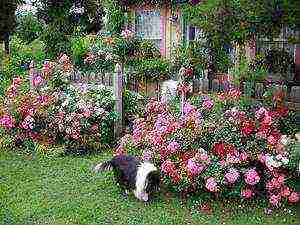 It is difficult to imagine a modern landscape design that would do without the use of ground cover roses. In addition to a special, aristocratic decorative effect, such roses can also perform a functional load - to strengthen the topsoil, thereby preventing soil leaching during floods in areas with hilly relief.
It is difficult to imagine a modern landscape design that would do without the use of ground cover roses. In addition to a special, aristocratic decorative effect, such roses can also perform a functional load - to strengthen the topsoil, thereby preventing soil leaching during floods in areas with hilly relief.
When designing a decorative site, it is worth remembering the most respectable neighbors for ground cover roses:
- the lower tier of planting - wormwood, santolina, silver sage, geranium, cuff, iris, herbs, ornamental onions;
- the middle tier of planting - dahlias, delphinium, hosta, foxglove, aerial cereals.
The latest squeak of fashion in landscape design, lasting for several seasons, is the neighborhood of ground cover roses and clematis.
The design of "living curbs" looks great in combination with monumental bouquets in garden vases.
Carpet-weaving varieties will be great decorating flowerpots or flowerpots.
A well-thought-out design is not only a decoration of the front space with compact shrub roses, but also filling the premises with a wonderful pink scent.
Popular varieties for Russia, Belarus and Ukraine
All the varieties of ground cover roses listed above in this article feel great in our climatic conditions. Below we list the name of the varieties that are most popular, good planting survival, high winter hardiness, disease resistance, unpretentious care, seedlings of which are easy can be bought in stores and nurseries:
-
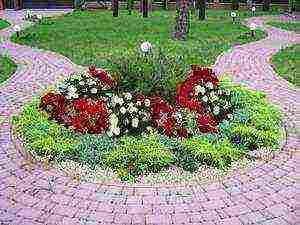 whites - Aspirin, Pearl Meyandecor, Sunny, Castelruther Spatzen, Snow Ballet, Sveny. Ivery Drift
whites - Aspirin, Pearl Meyandecor, Sunny, Castelruther Spatzen, Snow Ballet, Sveny. Ivery Drift - yellow - Sonnenshirm, Annie Dupre, Nadia Meijandekor, Vacations, Augusta Louise (with an orange border);
- pink - Penny, Palmengarten Frankfurt, Fairy, Lovely Fairy, Crazy, Rosita, Four seasons, Topolina, Bayernland Carpet;
- orange - Paul Cezanne (bush floribunda), Ethiopia, Fency, Apricot Clementine; Ninette;
- peach, cream - Pat de valur,
- red - Hello, Alpengluchen, Scarlet Meijandecor, Rouge Meijandecor, Cherry Girl, Meidy (with white lining), Rodi; Nostalgia.
- crimson and purple - Purple Hayes, Purple Rhine, Red Fairy, Prodzhe Ecarlat. Tornado.
Having made a choice in favor of ground cover roses, you are guaranteed to free yourself from unnecessary care and become the owner of regal bushes that bloom intensively throughout the summer.
Ground cover roses and their cultivation
The group of ground cover roses surpasses any other in terms of the variety of species and forms included in it. Among them you can find both undersized plants with long stems creeping along the ground, and taller ones, from which they picturesquely droop. Some, blooming with double flowers, have an emphatically romantic appearance, others are decorated more modestly - with flowers of simple shapes, but they do not lose at all from this. With all the external diversity, these roses have two very valuable properties in common: they are distinguished by unusually abundant flowering and the ability to maintain their magnificent outfits until autumn.
Groundcover roses include varieties with such distinctive features as frost resistance, significant outgrowth to the sides, rich, long flowering, abundant cover of shoots with shiny small leaves, resistance to black spot and powdery mildew, the most common diseases of roses.
Planting ground cover roses
Choosing a landing site. Groundcover, like any other type of rose, is very fond of light. Having the right access to the sun's rays guarantees long-term flowering and bud formation, but at the same time, direct exposure to the scorching midday sun is not desirable for plants - the petals can get burned and wither. Planting in shady areas of the yard and in the garden under trees, or near walls is not recommended, as the root system can get sick, growth will slow down and the plant may die.
For planting, you need to choose sunny places.
It is favorable to plant ground cover roses in the southeastern or western side of the plot, where the sun's rays will be in the morning, and the shade from shrubs and trees will help create the necessary protection in the midday heat.
Another very important point is that it is necessary to plant seedlings on a slope and, preferably, on an elevation of 30-40 centimeters - to drain melt water in the spring. Planting on an elevated level guarantees effective access to the sun in summer and protection from severe frosts in winter. It is necessary to take into account, when planting, the degree of soil moisture on the site - roses do not tolerate excessive moisture and acidity, and in winter, a high level of moisture in the soil contributes to hypothermia of the root system.
When to plant. For regions with warm winters, autumn planting of creeping and carpet roses in open ground is more preferable, and for areas with severe and frosty winters, planting in spring will be more reliable.
In regions with cold winters, planting roses in the spring is preferable.
When planting in autumn, it is necessary to shorten the shoots a little, since the main pruning of the flower is always done in the spring. In the spring, the shoots are cut in such a way that 2-3 buds remain in strong plants, and 1-2 in weak ones.
Preparing the landing site.In groundcover roses, the shoots droop low or creep along the ground, so weeding and planting can be a daunting task. To simplify it, the planting site should be prepared: remove large weeds, weed the soil. It is allowed to process it with "Roundup" followed by loosening.
All these actions are aimed at removing the stems and roots of harmful plants here and now. However, this is not enough, in order to further facilitate the care of plants, it is necessary to prevent their growth in the future. To do this, the soil between the planted bushes is mulched with bark, sawdust, decorative chips, black film. The thickness of the bulk mulch should be at least 3-4 cm so that weeds cannot germinate through it.
As for the composition of the soil, the most favorable soil for planting any roses is loamy, which transports moisture and oxygen well to the rhizome of the plant. Seedlings are poorly accepted and grow in dry sandy soils, which overheat in summer, freeze in winter and poorly retain nutrients. The best option for soil acidity is soil with a slightly acidic reaction in the range from 5.5 to 6.5 pH.
Landing. For planting, in the selected area, pits are formed with a depth of 50-70 cm and a diameter of about 50 cm; it is also permissible to dig a trench of the same depth and width as the landing hole during mass planting. The depth of the pit is formed based on the length of the roots of the seedling plus 10-20 cm.
During planting, it is advisable to water the soil layer by layer, which fills the hole - this way you prevent the formation of voids, and after planting you need to tamp the top layer of soil, water abundantly and spud the seedling. After the new growth on the bush reaches 5 cm, it is recommended to uncook and mulch the roses.
Depending on the variety of ground cover roses, per 1 sq. meter planted from one to three seedlings.
Caring for ground cover roses
Caring for ground cover roses does not differ much from caring for other types of roses. These flowers are considered unpretentious. They are rarely affected by diseases and are able to forgive some mistakes in care. The most important thing is to water them regularly and fertilize them as needed.
How to water. Watering should be done in the morning or when the sun does not shine directly on the bushes. If you neglect this rule, then the water that gets on the leaves will cause them to burn. For the same reason, it is impossible to spray and fertilize in the open sun.
As for the regularity of watering, both overflow and underflow are equally destructive for roses. Focus on the condition of the soil. Watering is necessary when the top layer of the earth dries out by 3-4 cm. In autumn, watering is reduced, gradually transferring the plants to a dormant period.
How to fertilize. Taking good care of your roses is primarily about feeding. During the growing season, ground cover roses can be fed 3 times. The first feeding is carried out in early spring, 2 weeks after the appearance of the leaves. As a fertilizer, you can use the drug "Cytovit", "Agricola for flowering plants" or other complex fertilizers with a ratio of components: nitrogen (N) - 1, phosphorus (P) - 2 and potassium (K) - 1 part.
The second feeding is carried out about a month later, and during the flowering period, fertilizer is not applied. To stimulate the second wave of budding, re-flowering varieties are fertilized immediately after the end of the first flowering (it is recommended to cut off the faded buds if the rose does not shed them by itself). In the autumn period, feeding is carried out only with potash fertilizers for good ripening of the shoots.
Groundcover roses do not require annual pruning, which makes it much easier to care for these plants.
Pruning. Ground cover roses are practically self-forming, do not require careful annual pruning, and this greatly simplifies the care of these plants. They bloom on shoots of different ages.
Many experts recommend not pruning groundcover roses at all in order to maintain their natural shape. The most important requirement when planting is to plant them at such a distance from one another so that the plants do not interfere with each other.
Shelter for the winter
Many varieties of ground cover roses, especially undersized ones, are able to winter without special shelter - under a layer of snow.In winters with little snow and harshness, one should not rely on such a natural "fur coat". It is best to cover the whips with spruce branches or build a wire frame and throw lutrasil over it. The air gap above the roses will reliably protect them from the winter weather.
You can build a wire frame and throw lutrasil over it.
Shoots of tall ground cover scrubs should be bent to the ground. The bent branches are placed on a layer of spruce branches, otherwise, under the shelter, plants in contact with the ground can rot. From above, the shoots are also covered with spruce branches or other insulating material.
Reproduction
Reproduction of ground cover roses by layering.
Groundcover roses are propagated by green cuttings and layering. The easiest way is to make layers. To do this, in the spring, press one or more shoots to the ground, fix them with wire hooks and dig in. The crown of the shoot should remain on the surface.
Keep the soil moist throughout the summer. No more care for the layering is required. Leave the layers to overwinter with the mother plant, so it will be more reliable. Separate the young plants the following spring and plant them in their permanent location.
Groundcover roses in garden design
Their main purpose is to cover the ground with thick leafy shoots growing horizontally and abundant inflorescences. The use of ground cover roses is largely determined by the nature of their growth.
These roses, with their long shoots dotted with numerous clusters of inflorescences, can be planted anywhere in the garden. They can be planted on flower beds, rocky areas of land, decorate slopes with them and cover hatches. Some highly prolific varieties are grown like climbing roses, directing their shoots upward on supports.
Groundcover roses have many faces and can be used in landscaping for different purposes. The simplest thing is to plant them on a green lawn.
Low-growing ground cover varieties can decorate paths and flower beds as a border.
Cascades of blooming ground cover roses falling from retaining walls, stone stairs, hills will add originality to a multi-level garden.
Roses look effective among stones, they are often planted in rockeries and on hills.
Low-growing varieties, creeping on the ground, look spectacular among stones, so they are often planted in rockeries and on hills.
Since ground cover roses have a very dense and dense bush, they can be grown in containers and flowerpots, and planted on open terraces.
The best varieties of ground cover roses
Fairy.
Fairy. Falling bush, compact, plant height - 60 - 80 cm, leaf is small, glossy, dark green. Disease resistance is very high, frost-resistant variety, shade tolerant, planting density is 5 pcs / m2.
Swany
Swany. Forms a sprawling, abundantly flowering bush. The flowers are pure white, with a pale pink tone in the center, when they just bloom, densely double, in the form of rosettes. Appears in clusters of 5-20 on rather long stems. Height 60 - 70 cm. Width 150 cm. The variety is resistant to powdery mildew.
Scarlet
Scarlet. Cherry red, cupped, double, 40-45 petals in one flower, flower diameter 3-4 cm, has a light aroma. Bush height 100 - 150 cm. Frost-resistant variety, high disease resistance.
Super doroti.
WITHstubborn Dorothy (Super Dorothy). The flowers are pink, 3 cm in diameter, 7-10 in inflorescences, the height of the bush is 70 cm, the length of the lash is 250 cm. The diameter of 1 bush is 2 sq. M. Used to decorate flower beds, like a climbing rose on a support.
Hello.
Hello (Rosa Hello).Dark red, purple, densely double, 110-120 petals in one flower, flower diameter 5-6 cm, by the end of flowering, the flower acquires a raspberry-cherry color. The height of the bush is 30 - 50 cm. Frost-resistant variety (up to -30 ° C).
Perhaps you are interested in other ground cover plants, you can read about them in the article "Ground cover perennial flowers for the garden"

